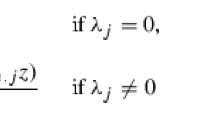Abstract
A steady-state, three-dimensional turbulent diffusion equation describing the concentration distribution of an air pollutant from an elevated point source in the lower atmosphere is solved analytically. The same formulation can be used to obtain solutions from line, area or other kinds of sources. The solution is developed for the cases in which the velocity, vertical and lateral diffusivities are given by the power law. The model preserves the beauty of analytical solution without sacrificing much on the accuracy of approximating the velocity and eddy diffusivities. Methods of evaluating the parameters, which are required for the model applications, are discussed. Results indicate that the ratio of the plume width to the plume length increases with decreasing stability and with increasing source height. These consequences are in response to the variations of the size of eddies in the vertical direction.
Similar content being viewed by others
References
Brutsaert, W. and Yeh, G. T.: 1970a, ‘A Power Wind Law for Turbulent Transfer Computations’, Water Resources Res. 6, 1387–1391.
Brutsaert, W. and Yeh, G. T.: 1970b, ‘Implication of a Type of Empirical Evaporation Formula for Lakes and Pans, Water Resources Res. 6, 1202–1208.
Businger, J. A., Wyngaard, J. C., Izumi, Y., and Bradley, E. F.: 1971, ‘Flux-Profile Relationships in the Atmospheric Surface Layer’, J. Atmos. Sci. 28, 181–189.
Calder, K. L.: 1949, ‘Eddy Diffusion and Evaporation in Flow Aerodynamically Smooth and Rough Surfaces: A Treatment Based on Laboratory Laws of Turbulent Flow with Special Reference to Conditions in the Lower Atmosphere’, Quart. J. Mech. Appl. Math. 2, 153–176.
Carslaw, H. S. and Jaegar, J. C.: 1959, Conduction of Heat in Solids, Clarendon Press, Oxford.
Davies, D. R.: 1947, ‘Turbulence and Diffusion in the Lower Atmosphere with Particular Reference to the Lateral Effect’, Proc. Roy. Soc. A190, 232–244.
Davies, D. R.: 1950, ‘Three-Dimensional Turbulence and Evaporation in the Lower Atmosphere’, I and II’, Quart. J. Mech. Appl. Math. 3, 51–73.
Dyer, A. J. and Hicks, B. B.: 1970, ‘Flux-Gradient Relationships in the Constant Flux Layer’, Quart. J. Roy. Meteorl. Soc. 96, 715–721.
Ellison, T. H.: 1957, ‘Turbulent Transport of Heat and Momentum from an Infinite Rough Plane’, J. Fluid Mech. 2, 456–466.
Frost, R.: 1946, ‘Turbulence and Diffusion in the Lower Atmosphere’, Proc. Roy. Soc. A186, 20–35.
Gifford,Jr., F. A.: 1961, ‘Use of Routine Meteorological Observations for Estimating Atmospheric Dispersion’, Nuclear Safety 2, 47–51.
Gifford Jr., F. A.: 1968, ‘An Outline of Theories of Diffusion in the Lower Layer of the Atmosphere’, in Meteorology and Atomic Energy - 1968, D. H. Slade (ed.), USAEC Report TID-24190, 65–116, July, 1968.
Hanna, S. R.: 1974, ‘Fog and Drift Deposition from Evaporation Cooling Towers’, Nuclear Safety 15, 190–196.
Kondo, J.: 1962, ‘Observations on Wind and Temperature Profiles near the Ground’, Science Reports, Tohoku University, Ser. 5, Geophys. 14, 41–56.
Laikhtman, D. L. and Panomareva, S. M.: 1969, ‘On the Ratio of the Turbulent Transfer Coefficients for Heat and Momentum in the Surface Layer of the Atmosphere’, Izv. Atmos. Ocean Phys. 5, 1245–1250.
Morse, P. M. and Feshbach, H.: 1953, Methods of Theoretical Physics, Part I, McGraw-Hill Book Company, Inc., New York, N.Y.
Panofsky, H. A.: 1961, ‘An Alternative Derivation of the Diabatic Wind Profile’, Quart. J. Roy. Meteorol. Soc. 87, 109–110.
Pruitt, W. O., Morgan, D. L., and Lourence, F. V.: 1973, ‘Momentum and Mass Transfer in the Surface Boundary Layer’, Quart. J. Roy. Meteorol. Soc. 99, 370–386.
Ragland, K. W. and Peirce, J. J.: 1975, ‘Boundary Layer Model for Air Pollutant Concentrations Due to Highway Traffic, J. Air Poll. Control Assoc. 25, 48–51.
Smith, F. B.: 1957, ‘The Diffusion of Smoke from a Continuous Elevated Point Source into a Turbulent Atmosphere’, J. Fluid Mech. 2, 49–76.
Sutton, O. G.: 1934, ‘Wind Structure and Evaporation in a Turbulent Medium’, Proc. Roy. Soc. A149, 701–702.
Sutton, O. G.: 1953, Micrometeorology, McGraw-Hill, New York, 333 pp.
Sutton, W. G. L.: 1943, ‘On the Equation of Diffusion in a Turbulent Medium’, Proc. Roy. Soc. A182, 48–75.
Swinbank, W. C.: 1964, ‘The Exponential Wind Profile’, Quart. J. Roy. Meteorol. Soc. 90, 119–135.
Swinbank, W. C.: 1968, ‘A Comparison Between Predictions of Dimensional Analysis for the Constant Flux Layer and Observations in Unstable Conditions’, Quart. J. Roy. Meteorol. Soc. 94, 460–467.
Watson, G. N.: 1966, A Treatise on the Theory of Bessel Functions, Cambridge at the University Press, Cambridge, Great Britain.
Webb, E. K.: 1970, ‘Profile Relationships: The Log-Linear Range and Extension to Strong Stability’, Quart. J. Roy. Meteorol. Soc. 96, 67–90.
Yamamoto, G.: 1959, ‘Theory of Turbulent Transfer in Non-Neutral Conditions’, J. Meteorol. Soc. Japan, Ser. 2, 37, 60–70.
Yamamoto, G. and Shimanuki, A.: 1960, ‘Numerical Solution of the Equation of Atmospheric Turbulent Diffusion, Science Reports, Tohoku University, Ser. 5, Geophys. 12, 24–35.
Yeh, G. T. and Brutsaert, W.: 1970, ‘Perturbation Solution of an Equation of Atmospheric Turbulent Diffusion’, J. Geophys. Res. 75, 5173–5178.
Yeh, G. T. and Brutsaert, W.: 1971, ‘A Solution for Simultaneous Turbulent Heat and Vapor Transfer Between a Water Body and the Atmosphere’, Boundary-Layer Meteorol. 2, 64–68.
Yeh, G. T.: 1975, ‘Green's Functions of a Diffusion Equation’, J. Geophys. Res. Letters 2, 293–296.
Yih, C. S.: 1952a, ‘On a Differential Equational on Atmospheric Diffusion’, Trans. Amer. Geophys. Union 33, 8–12.
Yih, C. S.: 1952b, ‘Similarity Solution of a Specialized Diffusion Equation’, Trans. Amer. Geophys. Union 33, 356–360.
Author information
Authors and Affiliations
Additional information
Now at Tetra Tech, Inc., 630 N. Rosemead Blvd., Pasadena, California, U.S.A.
Rights and permissions
About this article
Cite this article
Yeh, GT., Huang, CH. Three-dimensional air pollutant modeling in the lower atmosphere. Boundary-Layer Meteorol 9, 381–390 (1975). https://doi.org/10.1007/BF00223389
Received:
Issue Date:
DOI: https://doi.org/10.1007/BF00223389




